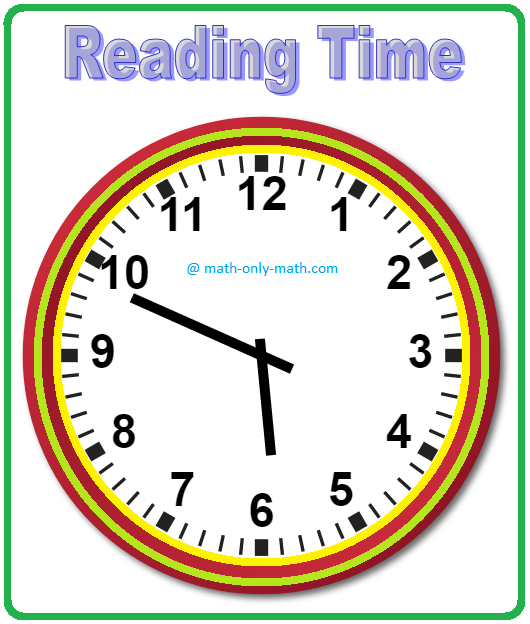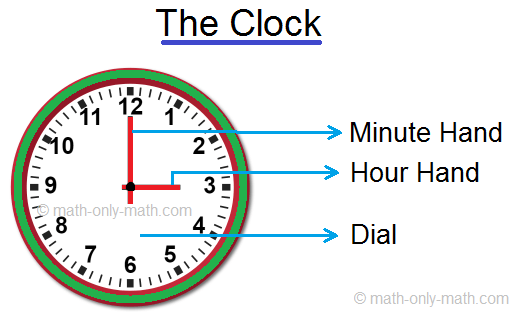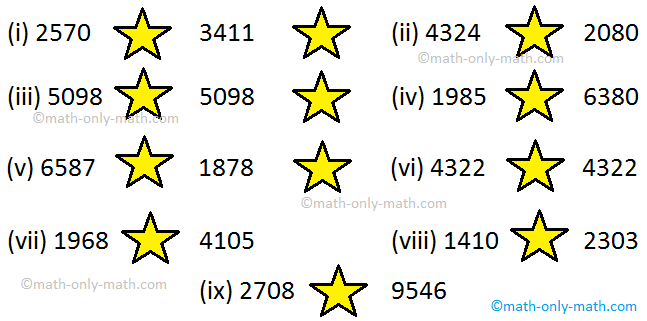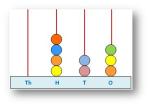Different Ways of Reading Time
Let us recall what we have learnt about reading time from a clock.
1. For measuring time we need clock which tell us hours, minutes and seconds.
2. The clock has 12 numbers. The space between these numbers are divided into five equal parts. These parts indicate minutes.
3. 60 seconds make a minute and 60 minutes make an hour.
4. When minute hand is on 6, we say half past.
5. When minute hand is on 3, we say quarter past
|
The clock has two hands. The short hand is the hour hand. It shows time in hours. The long hand is the minute hand it shows time in minutes. The clock has numbers from 1 to 12 marked on its face, called dail. When the minute hand points to 12 the time shown is a full hour. In the clock given here the hour hand is at 3 and minute hand is at 12. The time shown on the clock is 3 o’clock. |
When the minute hand points at 6, we say 30 minutes past an hour or half past an hour.
Reading Time to the Exact Minutes
Look at the Clock:
|
The hour hand is between 5 and 6. Therefore, the time is between 5 o'clock and 6 o'clock. Count the Small Divisions: As we know up to 6 there are 30 small divisions and we also know that there are 5 small divisions between every number. So up to 9 there are 45 small divisions. Count after 45. There are 4 small divisions ahead of the number 9. i. e., 45 + 4 = 49 or, (9 × 5) + 4 = 49 So, the time is 5:49. |
 |
What are the Different Ways of Reading Time?
There are many ways to read time:
(a) When hour-hand is exactly at any number and minute-hand is at 12, we read the time in full hours. If hour hand is at 8 and minute hand is at 12, then it is 8 o’clock.
(b) When the minute-hand is at 6 and hour hand between two consecutive numbers, then the time has the first of the two consecutive numbers as hour and minute 6 × 5 = 30.
If the hour hand is between 7 and 8 and minute-hand at 6, the time is 7:30.
It is also called half past 7. Similarly, 11:30 is half past 11.
(c) When the minute hand is at 3 or 9, the time is in quarter hours.
If the minute hand is at 3 and hour hand between 5 and 6 then time is 5:15. It is called quarter past 5.
If the minute hand is at 9 and hour hand between 5 and 6 then time is 5:45. It is called quarter to 6.
(d) It has already been described that the time between midnight and noon is known as A.M. and between noon and next midnight is known as P.M.
For example: 9:35 in the morning is written as 9:35 A.M.
9:35 in the night is written as 9:35 P.M.
These are the different ways of reading time observing the hour – hand and minute – hand. Some clock has second hand which is generally not observed while telling the time, the position of the hour – hand and minute – hand indicate the time shown in the specific clock.
Worksheet on Different Ways of Reading Time:
I. Write the correct time in the given box:
Answer:
(i) 4 O'clock
(ii) 7 O'clock
(iii) 12 O'clock
(iv) 1 O'clock
(v) 9 O'clock
II. Read the time and draw both hands of the clock to show the given time.
or, Look at the time below and draw the hands accordingly:
Answer:
III. Draw the hands on the clock faces to show the given time.
Answer:
IV. Write the correct time in the given box.
Answer:
(i) 2:30
(ii) 8:30
(iii) 9:30
(iv) 4:30
(v) 10:30
● Related Concept
From Different Ways of Reading Time to HOME PAGE
Didn't find what you were looking for? Or want to know more information about Math Only Math. Use this Google Search to find what you need.
Recent Articles
-
Arranging Numbers | Ascending Order | Descending Order |Compare Digits
May 19, 24 10:46 AM
We know, while arranging numbers from the smallest number to the largest number, then the numbers are arranged in ascending order. Vice-versa while arranging numbers from the largest number to the sma… -
Worksheets on Comparison of Numbers | Find the Greatest Number
May 19, 24 10:42 AM
In worksheets on comparison of numbers students can practice the questions for fourth grade to compare numbers. This worksheet contains questions on numbers like to find the greatest number, arranging… -
Comparison of Numbers | Compare Numbers Rules | Examples of Comparison
May 18, 24 02:59 PM
Rule I: We know that a number with more digits is always greater than the number with less number of digits. Rule II: When the two numbers have the same number of digits, we start comparing the digits… -
Numbers | Notation | Numeration | Numeral | Estimation | Examples
May 12, 24 06:28 PM
Numbers are used for calculating and counting. These counting numbers 1, 2, 3, 4, 5, .......... are called natural numbers. In order to describe the number of elements in a collection with no objects -
Face Value and Place Value|Difference Between Place Value & Face Value
May 12, 24 06:23 PM
What is the difference between face value and place value of digits? Before we proceed to face value and place value let us recall the expanded form of a number. The face value of a digit is the digit…















New! Comments
Have your say about what you just read! Leave me a comment in the box below. Ask a Question or Answer a Question.